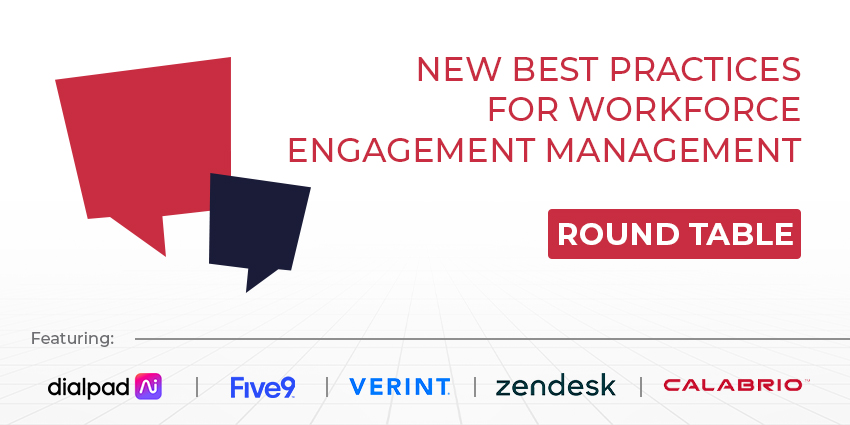Contact center workforce engagement management (WEM) practices have evolved rapidly in recent years.
The chief catalyst? Advancements in AI.
Indeed, AI is reshaping how organizations manage their workforces, optimize operations, and deliver superior customer experiences.
Recognizing this, CX Today reached out to five experts to understand how the two primary areas of WEM – workforce management (WFM) and quality assurance (QA) – are evolving.
These industry specialists are:
- Vincent Paquet, Chief Product Officer at Dialpad
- Tim Richter, Senior Director of Product Marketing at Five9
- Trudy Cannon, Senior Director, Go-To-Market Strategy, for Verint
- Matthias Goehler, Zendesk CTO EMEA
- Richard Lea, Senior Consultant at Calabrio
Below, the panelists share their best practices across these remits of WEM and beyond.
New Best Practices For Workforce Management (WFM)
Forecasting for the Impact of AI
Paquet: Contact centers are adapting their WFM strategies by forecasting contact volumes based on how many tickets will be triaged/resolved by AI.
Additionally, they’re adding scheduling flexibility for agents to handle escalations from bots and implementing comparative performance metrics across humans and AI.
To help, planners are leveraging AI themselves.
Moreover, by using AI forecasting, they are more accurately identifying outliers in volumes and predicting resources required for customer-facing and back-office tasks.
Lastly, planners are utilizing AI-based, real-time analysts to surface volume/capacity changes and recommend the right course of action.
Continual Re-Training
Richter: It’s critical to ensure planners are continually retrained to fully utilize the latest AI-based forecasting and scheduling tools.
It may not be a new best practice, but it’s more relevant now than ever, given the large number of contact centers migrating from legacy premise-based solutions and spreadsheets to the cloud.
Workforce planners accustomed to running legacy WFM solutions may not yet have the knowledge or experience to operationalize the latest cloud-based, AI-enabled WFM solutions.
For one customer, we (Five9) noted that workforce planners took three days to create a schedule in their legacy WFM solution for a short time, even though they recently deployed a modern cloud WFM application.
The planners were simply set in their ways and not adequately trained.
With the new Five9 WFM solution, they got that three days down to 75 minutes.
Forecasting for Customer Journey Trends
Cannon: One emerging best practice is recognizing the impact of CX Automation on WFM, emphasizing the need to forecast for interactions that start in and span multiple channels.
Now that organizations are embracing AI and automation, customer journeys have become even more dynamic.
This makes it difficult to forecast customer interactions, which was already challenging to predict.
As such, WFM forecasting and scheduling must be agile and flexible. Organizations should monitor shifting customer journey trends so they can scale capacity up or down to meet customer needs.
Personalized Employee Schedules
Goehler: AI-powered WFM goes beyond simply offering flexibility. It analyzes employee data to align tasks and projects with their strengths and interests, improving engagement and job satisfaction.
At the same time, it helps organizations manage resources and reduce costs by assigning the right people to the right tasks at the right time.
Many companies have successfully adopted this approach to achieve cost savings and improved workforce satisfaction.
A key advancement in WFM is the integration of AI to create personalized employee schedules.
These schedules consider individual preferences, skills, availability, and career goals while optimizing workforce utilization across brands, countries, languages, and support tiers.
Another important aspect of AI in WFM is its ability to adapt schedules in real time, responding to changes in availability or workload fluctuations without compromising efficiency.
Overall, it prioritizes both employee empowerment and business outcomes.
New Best Practices For Quality Assurance (QA)
AI Automated Scorecards
Paquet: AI allows graders and supervisors to dramatically increase the number of calls they can score in QA.
Without AI, the number of calls graded is routinely in the sub-five percent range.
AI-Assisted scorecards will suggest some answers to the scorecards but will rely on a human grader to confirm the score.
This saves time as graders can simply click on the suggested score and be brought automatically to the relevant part of the transcript to validate the AI-suggested score.
Think Beyond Agent Performance
Richter: It’s essential to look for quality management to deliver insights beyond opportunities to improve agent soft or hard skills.
In particular, consider how quality management can help discover and correct operational bottlenecks and identify automation opportunities.
One healthcare insurer used quality management to uncover that agents spent, on average, 30 seconds at the front end of calls just to authenticate members.
As a result, they automated the authentication process and instantly shaved 30 seconds off agent handle time.
Soft and hard skills remain core to quality management, but quality management can (and should!) do more.
Continuously Evolve Quality Scorecards
Cannon: Organizations can’t achieve their quality objectives with manual checkboxes and static forms.
The biggest issue with a static form is that contact centers assume the questions and criteria align with how they want the customer experience to evolve.
However, customer journeys are evolving so quickly that service teams can be caught “flat-footed” trying to measure performance against criteria one step behind.
How does a contact center listen to ensure every interaction meets our desired standard? Automation. The caveat is not everything is going to be automated, and that is not the goal.
The goal is to introduce automation to provide the scale and visibility necessary to guide coaching – both automated real-time guidance and via supervisor engagement.
Automation frees supervisors to have the time for mentoring and coaching.
Enhancing Employee Engagement
Goehler: From a tech perspective, the next frontier in QA is leveraging AI-driven insights to enhance employee engagement.
AI enables organizations to monitor 100 percent of interactions across all channels, including those managed by AI agents, flagging relevant conversations for review.
This ensures consistency and allows organizations to address quality issues proactively.
In today’s world, this is essential for maintaining consistency and addressing quality issues early.
With prompt-based QA, organizations can customize how they review interactions, tailoring criteria to fit specific goals or challenges.
Integrating these insights into workflows gives employees real-time guidance that builds confidence and drives ongoing improvement.
As a result, organizations can maintain consistent quality while empowering their workforce to perform at their best.
Leverage Live Agents
Lea: High-performing agents have a wealth of experience and tips and tricks at their disposal – so harness the power of those agents.

Facilitate agent focus groups and capture their best practices in areas such as desk organization and computer use, tips on call control and de-escalation, optimal tool use, documentation best practices, etc.
Capture everything in a presentation and publish and utilize these tips with the broader agent population.
The supervisor can take these tips and incorporate them into their coaching tips. These are incredibly powerful in helping drive quality and productivity.
Best Practices for WEM Beyond WFM & QA
Agentic AI

Paquet: Agentic AI will automate more tasks that are currently manually done by human agents, which will impact their productivity.
Similarly, real-time AI will surface more and more relevant content to the agents based on ongoing conversations at the moment, ready to be consumed by the human agents.
Companies using these tools will have more productive and fewer agents in recruiting and onboarding recruiting and onboarding costs.
Deep Domain Expertise
Richter: No two companies or industries are the same, and brands need experienced professionals with deep domain expertise in their respective sectors to finely tune workforce engagement practices.
For example, a large healthcare provider employs quality assurance (QA) associates with a deep understanding of patient relations.

Through conversational intelligence, they uncovered that agents were not expressing sufficient empathy when patients called to schedule appointments for newly diagnosed diseases.
Training programs were implemented, and agents improved how they related to and welcomed new patents.
Agent satisfaction increased due to their new empowerment, with the percentage of agents with at least one year of experience increasing from 35% to 60%.
Employee Empowerment Through Gamification
Cannon: There’s been a lot of talk about employee empowerment, but it’s time for organizations to act.
Research has shown that younger generations in the workplace want to feel as if they make a difference and own the organization’s mission.
We have a bot that employs gamification to empower employees to have agency over their schedules – i.e., swap a shift on Tuesday for Thursday, start an hour later on Friday, etc. – while enabling the organization to have the requisite schedule coverage and capacity.

This new best practice also frees supervisors from onerous and time-consuming scheduling tasks.
Another key benefit is giving employees the ability to see instances where the organization is short-handed so they can understand the business realities and adopt an ownership spirit.
This is moving WFM from a “command-and-control” approach to one that underscores employee empowerment and improves employee retention and satisfaction.
Conversational Intelligence
Goehler: The real opportunity in WEM lies in using conversational intelligence to transform learning and task allocation into an active, data-driven process.
AI can analyze agent-customer conversations in real time, identifying areas for improvement and success stories. These ‘golden moments’ can be shared within learning systems as best practices, fostering collaboration and peer-to-peer learning.
Additionally, insights from QA data can highlight performance trends and skill gaps, which can inform WFM strategies.

For example, if Optical Character Recognition (OCR) identifies that an agent struggles with certain request types, those tasks can be reassigned until training has been concluded.
Similarly, QA data can highlight workload imbalances or areas where additional support is needed, allowing managers to optimize scheduling and resource allocation.
This creates a dynamic system where conversational intelligence drives personalized coaching, smarter task allocation, and optimized workforce planning.
Miss out on our previous CX Today roundtable? Catch up here: Copilots & Virtual Assistants: Emerging Use Cases, Trends, & Strategies







